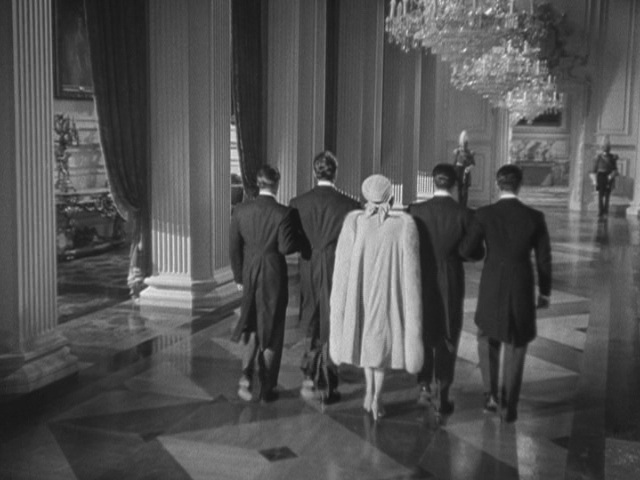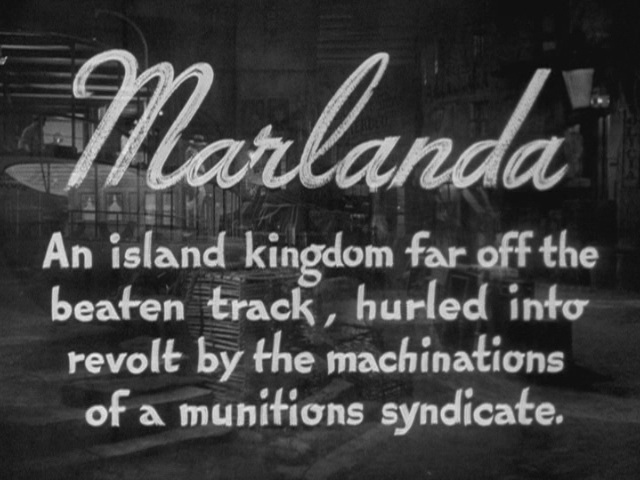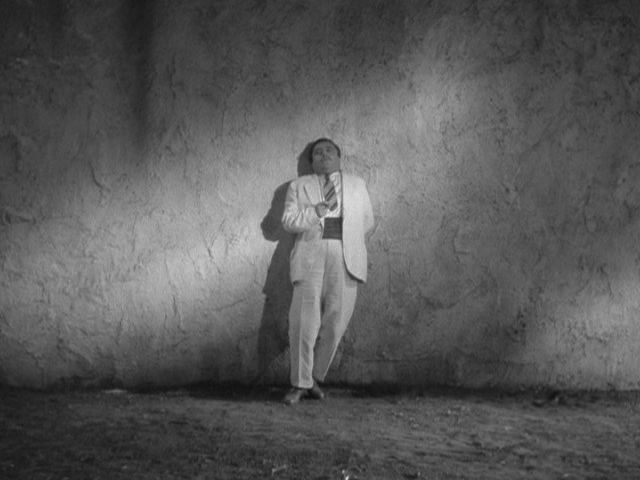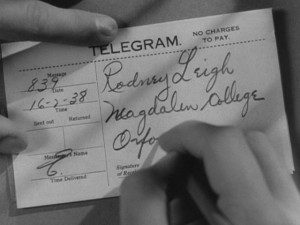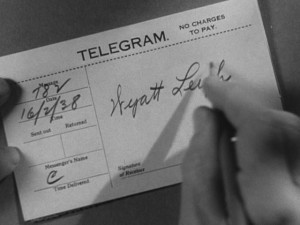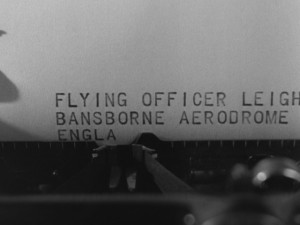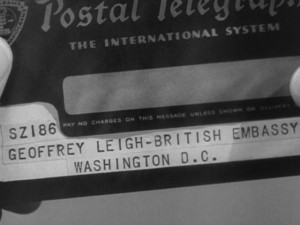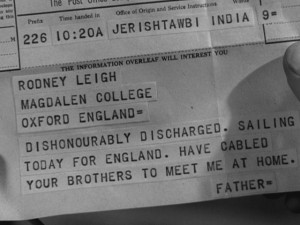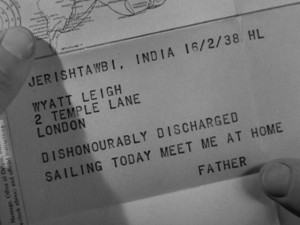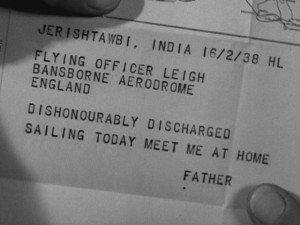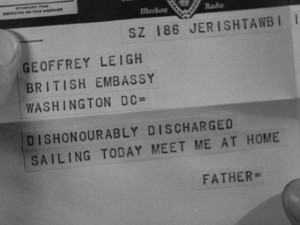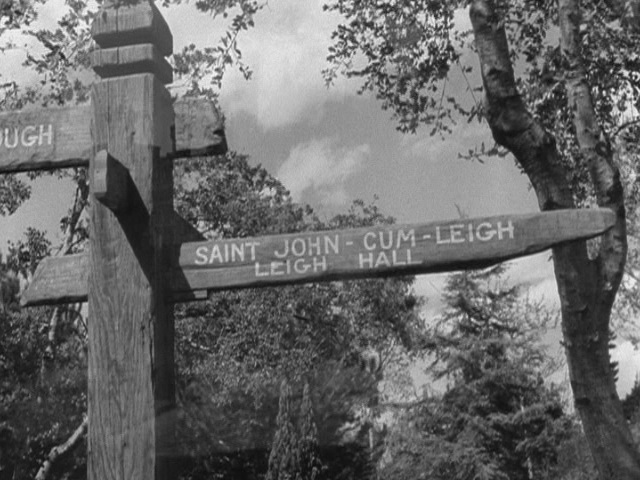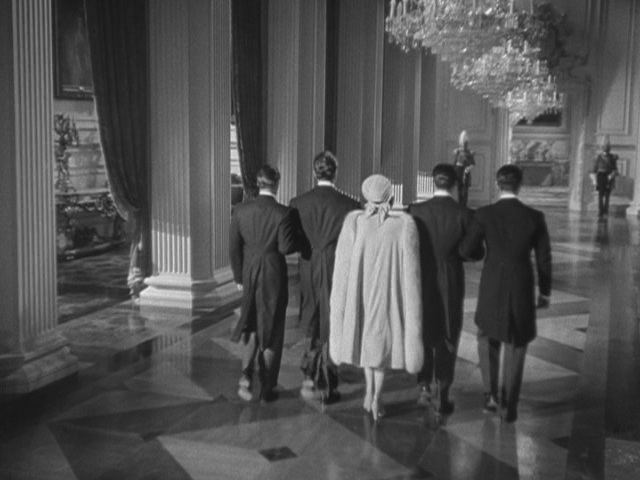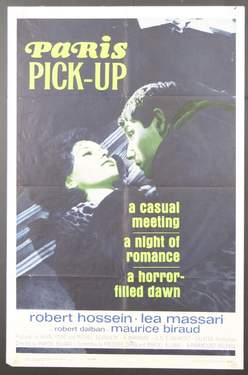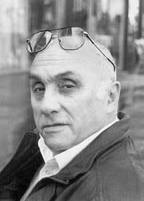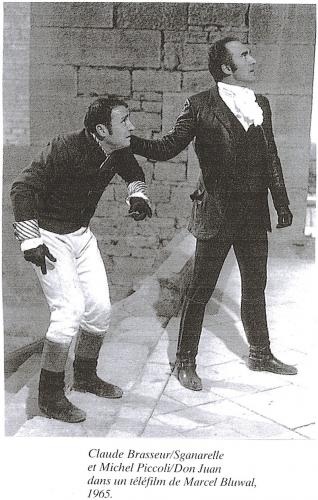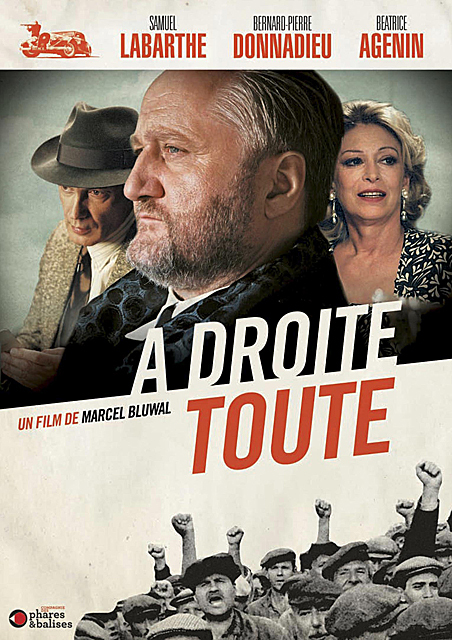Four Men and a Prayer (1938)
Let’s get this straight first off: Four Men and a Prayer is not a religious picture. Far from it. Or, at least, given the angelic overtones of this last shot, it is no more a religious picture than Doctor Bull is.
The print on the DVD is excellent. There are no extras. It shares a disc with Seas Beneath. My DVD got somewhat scratched because of the box’s poor packaging, but the scratching has not affected the image or sound quality.
In the book that comes with the Ford At Fox box, Joseph McBride suggests that Four Men and a Prayer was a film “that other directors could have done just as well” (17). [1] Bertrand Tavernier, writing in 1965, said that Ford had been constrained by the conventions of Hollywood in the 30s but that nonetheless “his exceptional personality had allowed him to surmount a number of obstacles and to sign several amusing films (Four Men and a Prayer [1938], Steamboat ‘Round the Bend [1935])”. [2] Ford himself said, “I just didn’t like the story, or anything else about it, so it was a job of work”. [3] On the surface, the film certainly feels like a job of work. But the more attention one pays to it the stranger it becomes until one is hard put to imagine anyone else but John Ford having directed it.
I think that perhaps there are questions of Art lurking about in those quotes. Some critics, and Ford himself no doubt, might be thinking that really this sort of bread-and-butter movie is somewhat beneath what John Ford had become by 1938, and was so surely to become in the next decade and more. Tag Gallagher is a lot more balanced:
Neither [Four Men and a Prayer nor Submarine Patrol] explores any deep theme, yet both display allegretto virtuosity, deftly vignetting large casts and variegated modalities. Expressionism is moderated; and, as in Winkie, depth-of-field blocking and cutting, graceful camera movements, and animated reaction shots are employed more as in fifties than as in thirties Ford. [4] The scripts, moreover, are trivial skeletons for the director’s invention.
Four Men — with its subtle verbal gags, ridiculous costumes, butlers and chewing gum, with Berton Churchill a hysterically sober tycoon, Loretta Young a Hawksian screwball, and George Sanders a pompous attorney, with Barry Fitzgerald drinking midst Ford’s first friendly barroom brawl, every European in India carrying an umbrella, and Alexandrian bellboys wearing “Sphinx Hotel” sweaters — is an affair best appreciated by Ford cultists. Its uncharacteristically lampooning direction makes the story — of four sons globe-hopping to clear their father’s name — almost meaningless. (162-163)
No “deep theme”, instead “trivial skeletons”, “an affair best appreciated by Ford cultists”, “the story … almost meaningless”. No matter, at least he seems to have had fun – and having fun is surely the point of Four Men and a Prayer.
Or at least it is to some extent. And one of the most interesting things about this movie is the strange balance it strikes between having and not having fun (“variegated modalities”). In spite of both Gallagher and Peter Bogdanovich, not to mention Ford himself (prompted by Bogdanovich), I am not so certain about “lampooning direction” (much less “uncharacteristically”), [5] which would suggest that Four Men and a Prayer goes all around the cobbler’s bench without the weasel popping even once. That is not what happens. Instead the direction is marked by hyperbolic moments in which one is not quite certain how to take the film’s exaggeration. [6]
The first of these comes at the climax of the first scene. Colonel Loring Leigh (C. Aubrey Smith) is facing an unsympathetic, perhaps corrupted, court martial in India. He rises to testify on his own behalf, and muffled drums roll on the soundtrack as the scene ends. Surely this extra-diegetic sound is an extreme way to convey that the verdict will go against him. But is the intent here to tell us that the matter is a serious one, a kind of remake of the overblown tribunal in The Prisoner of Shark Island in which we know the exaggeration was in deadly earnest? Or is it some kind of joke about the conventions of military fiction? A foreshadowing of Colonel Leigh’s impending murder and/or the execution by firing squad that occurs later in the film? Or – and I rather like this one – just a little prod to keep careful viewers on their toes?
The tone continues to veer through the brief establishing scenes which follow. When Leigh’s four sons (!) receive telegrams telling them of their father’s disgrace and calling them home, each drops what he is doing and heeds the call of family duty. Rodney (William Henry) is on the rowing crew at Oxford, Wyatt (George Sanders) is a barrister in mid-trial, Christopher is an officer in the Royal Flying Corps with lady trouble, and Geoffrey (Richard Greene) is decoding messages at the British Embassy in Washington, besieged by the beautiful and wayward Lynn Cherrington (Loretta Young). In no instance does any of them have the slightest hesitation in walking away from what the rest of us might call “their duty” to heed the call of pater in distress.
But of course, British reticence forbids either the boys asking what has happened or the Colonel revealing the evidence that can clear him before he can be murdered and that crucial evidence stolen. Wyatt, the eldest, whimpers when they discovers their father’s body. Whimpers. Then, as a kind of hyperbolic emphasis of what is already a hyperbolic aural moment, he does it again.
It is difficult to know how to respond to this noise. If the melodrama of the scene had been being stressed rather than its rather dispassionate-but-fun mystery story aspect, one would understand what Sanders does as fitting in with the pathos of the moment. But that is not what is happening. Sanders appears to be struggling for control throughout the scene; he leaves the other brothers to discover the Colonel’s empty attaché case and the open window. This is a very peculiar thing. At first I thought, “I didn’t know that George Sanders could make that sound”. And then, “Twice?”. And a little later on in the film I thought, “That was a good way to show that Sanders was a versatile actor because he’s not getting many other opportunities”. And later still, “Everyone in this pictures seems to do some schtick; I wonder if that whimpering was Sanders’ schtick”. [7] The point is that the whimper is not directly reprised until the very end of the film, when Wyatt whimpers again in acknowledgement of the posthumous medal the King has just granted dear old Dad. Both the whimper and the drumroll are moments of a different order from the universe of the film’s conventional story. Juste des bruits, pas des bruits justes.
Traditionally this is what happens with gags. Each gag breaks narrative continuity in order to establish an internal continuity of its own. Then the narrative resumes, even if it is only to string another gag after the first, leaving gags in its wake like chaff for air-to-air missiles. But it is also the case that popular art in general is most often remembered in hyperbolic moments: quotable lines and images, hooks and screams. And these may be comic or tragic, impossible or all-too-quotidian. They are the souvenirs of a certain experience of art, glittering baubles in the palm of one’s hand, deflecting attention from more important things, time stained indelibly with motion in the replay of sensations. Narrative gives way to incident and image, to disconnected moments imagined anachronistically.
Four Men and a Prayer – Video 2 from Screening the Past on Vimeo.
“. .. ou burlesque: les apparitions du Chinois dans Quatre hommes et une prière” [8] The Chinese guy is not the only one providing the “burlesque” here.
Let me now consider two other incidents which detach themselves from the narrative. They are linked chronologically to each other in one sequence and, by virtue of certain formal similarities, to Colonel Leigh and his counterpart, The Bad Guy – who is a more elusive figure than you might think.
The film began by discovering Colonel Leigh in India to the beat of a quasi-native drum and the only solid thing Leigh told his sons before he was killed was that his dishonourable discharge “was the work of a munitions syndicate”. Now here we are in an “island kingdom” in the tropics, having moved from India to England, via Washington, and thence on to Brazil and back to India in pursuit of the Colonel’s murderers and the arms consortium behind them. Narratively, “Marlanda” is a South American country not terribly far from Brazil and accessible to the characters by boat. But really it is a no place, distinguished by its blatant fictionality from the other countries in the film (which mandates the explicatory statement in the title above), thus a kind of distillation of those places, or at least, what those places are doing in this film. It is, as we realise almost immediately, a strange, still location where there are no humans actually on the street – that is, a place where something untoward is about to happen.
The characters arriving in Marlanda are a Mixed Lot which, like the Tropical Town of Impending Doom, is one of the requirements of this sort of story. But something about the mixture here is a tad askew. The Madcap Girl, Lynn, has made a super-fast airplane journey to Buenos Aires in order to one-up Stiff Upper-Lipped Geoffrey, who has refused her help. She has hooked up with Douglas Loveland (Reginald Denny), who is an old acquaintance, who testified at Colonel Leigh’s court martial, and is a Person Of Interest at this stage of the investigation. Geoffrey makes it to Buenos Aires by boat some time after Lynn gets there but is at first unaware that she is in town. Dashing Christopher has previously flown in from England and, fast worker that he is, has taken up with Lynn, whom he otherwise does not know. By so doing, he believes he has cleverly attached himself to the object of the investigation. Christopher finds Lynn attractive, which distresses Geoffrey, who truly loves her but thinks of her as an airhead. Lynn, hugely enjoying her success in ensnaring Loveland and misleading Christopher, plays on Geoffrey’s jealousy of both of the others. One of Loveland’s mates owns a yacht. This is Peter Furnoy (Alan Hale), a Suspicious Rich Guy who turns out to be an International Arms Dealer (Loveland is his second-in-command). Also aboard is General Torres (J. Edward Bromberg), a somewhat comical South American Military Stereotype, not to mention the Chinese waiter to whom Tavernier refers.
The yacht has only tied up at Marlanda’s dock because of some business that Furnoy has with Torres there. They start off together along the deserted streets together, when Furnoy suddenly has second thoughts: “Let fools be heroes. It’s their business. Mine is selling arms.”.
He leaves. But Lynn has determined that she will also go ashore, and she enlists Loveland as her escort, despite his misgivings. They see Torres entering a warehouse and Lynn decides to follow him. Inside are the rebels we have been expecting ever since that introductory title, and of course Torres is their leader.
Lynn and Loveland then witness Torres’ arrest and execution. The execution is not, at first, treated seriously. Until this sequence Torres has been portrayed as a rather inept blowhard, although his belief in the rightness of his cause is not questioned by the film, and the cause itself is not belittled (that is, the revolutionaries are given noble close-up inserts [9] ).
He is offered the traditional last cigarette.
General Torres: “Forgive me, my friend, but you know I do not smoke.”
General Sebastian [John Carradine]: “But my friend, people are watching.”
Torres: “You are very thoughtful. Graçias.” [Takes cigarette, coughs slightly after it is lit].
His death, after this bit of byplay, is perhaps all the more shocking.
Certainly the sight of it causes Lynn to scream. And this causes the detached viewer to observe that Loretta Young seems to be having way too much fun throughout the movie, even when, as in this instance, she is playing a a character who is not. One of the peculiar things about Four Men and a Prayer is the way in which it plays with the viewer’s awareness of the movie personae of many of the major characters. In this way the film builds on the director’s success with Will Rogers’ ability to intersect his star personae and the characters he played, but here the fit is not at all precise and the viewer is continually made aware of what can be at stake in the question of how characters are constructed in the cinema: Loretta Young, David Niven, George Sanders, and then again Alan Hale, John Carradine and, as we shall see, Berton Churchill – all make their appearances simultaneously as “themselves” (or, more accurately, as what they appear to be) and as characters in a story.
Such a perception as I have described depends for some of its effect on the viewer’s sense of the personae of the actors on the screen. (The perception of something askew can also be triggered by a sense of something wrong or misjudged in the performance, that is, in one’s perception of the performance as separate from the fictional being of a character). Thus the list I have made above depends very much on my sense of the actors on that list and of the use to which Ford is likely to have put them. On the other hand, J. Edward Blomberg, who plays Torres, was exactly the kind of actor who avoided being typed even as “himself”: he played every kind of character part with neither fear nor favour (and no little ability). [10] Ford used him, not for the persona that he brought to the screen but for his ability to create the conventional fictional character of General Torres.
Torres’ execution precipitates a counter strike by the other revolutionaries, whose faulty ammunition has been supplied by Loveland and Furnoy. The subsequent massacre of the revolutionaries is not treated humourously, although certainly there is scope for that in the classically comic discovery that what you have thought ensured you victory is actually what will lead to your downfall. Lynn screams again, and she and Loveland flee the scene.
Four Men and a Prayer – Video 3 from Screening the Past on Vimeo.
What happens in Marlanda, Part 2. Note that the sound of repressive machine gun fire is louder than that of defiant human voices.
The two hyperbolic incidents are not only linked chronologically and logically – the one causing the other – they are also linked by Lynn’s reaction, the deadly fire of heavy machine guns, the glee of those firing them, and the courage of their victims, who welcome their fate.
As I have said, these syntagmatic linkages are bolstered by paradigmatic or structural ones. General Torres’ situation has been engineered by the same arms syndicate that brought about Colonel Leigh’s dismissal from the service. But in addition, Leigh’s murder, the murder of a good father, has motivated the sons’ mission of restitution and revenge – clearing their father’s name and the elimination of the person responsible for his murder. Although the film apparently finally settles on Furnoy (a man who is visibly older than any of the four sons) as the most blameworthy party, for quite a long time it fingers Lynn’s father, Martin Cherrington (Berton Churchill), who is the head of Atlas Arms, the syndicate in question. Lynn only gets serious about what she is doing when she experiences firsthand Torres’ execution and the massacre of his followers.
Loveland: “That’s war, you know.”
Lynn: “It isn’t war, it’s a massacre.”
Loveland: “It’s all a surprise to me.”
Lynn: “The men who sell them ammunition, encourage that sort of thing, who ought to be shot – not those poor little devils!”
Reciprocally, Geoffrey only gets really serious about Lynn after she helps to rescue him from a Marlanda firing squad (speaking a bit of Spanish while she is doing it). More importantly, the movie only gets serious about what is going on after this. Lynn’s experience, her reaction and her relationship to the head of Atlas Arms snatch the way the film thinks away from the immature English boys and place it into the caring hands of the American woman. [11] Maternity is doubtless not quite the right word here; I can’t help thinking of Wendy and the lost boys of Never Never Land.
Crucially – or critically – then, it is General Torres’ execution, with its strange bit of humour, that seems to be the nexus of the film’s narrative, and thus in some measure its emblematic event. But it also seems that the variation of that event, in which the original execution is embedded, multiplied and transformed, is equally significant to this film’s rather bizarre structure.
Furnoy speaks with Lynn after the suppression of the rebellion, and just following an interview with Geoffrey and Christopher, who have accused him of having a hand in the munitions business. “You know, men will fight,” Furnoy says to her, “War’s a pretty old institution”. Furnoy tells Lynn that her father is in Alexandra (Egypt). He also tells her that her father is President of Atlas Arms, the munitions syndicate that she knows has been fingered as acting to promote revolution in order to sell more arms. This is the first she has learned of her father’s connection with the company.
Not a digression, but a discovery
One of the most productive aspects of Bertrand Tavernier’s “La Chevauchée de Sganarelle”, referred to above, is that it takes the reader step-by-step from one’s initial impressions of certain general recurring tropes in Ford’s films to the ways in which those general ideas are deployed in specific, thus more or less “Fordian”, ways.
Tavernier claims that a significant number of the films he is writing about
are all group odysseys, undertaken by several people belonging to the same milieu, the same collectivity. Ford is only interested in personal problems, historical or otherwise (biographies of gun fighters or adventurers), to the extent that they resume those of the community.(3)
Now this is not so for many of the Ford films with which this review has been concerned (Just Pals, Hangman’s House, Doctor Bull, Judge Priest) but the idea of a “group odyssey” obviously underpins most of the others as well as almost all of Ford’s best known work. In the case of those in which such a journey is undertaken by only one person (Louis Beretti, Doctor Mudd) it seems to me that those protagonists are indeed intended to represent a larger collectivity (of veterans, of southerners), just as Hannah Jessop is intended to represent grieving mothers. And at the same time those films not about topographical odysseys seem to me to be about historical-social ones.
I do not know whether Tavernier was the first critic to have stressed this aspect of Ford’s work, but he was certainly the earliest to have made an impression on me, and I believe that what I have quoted is more or less taken for granted in most writing about Ford these days. This cannot be said of everything Tavernier writes in this piece, as is attested in the quote below.
Ford insists, moreover, on the dissension, the discord, that divides a collectivity, and his heroes only react as a function of the milieu in which they live, and which imposes on them a task that must end successfully in order to ensure everyone’s happiness. It could be said, simplistically, that the Fordian hero does not pose a moral question, or if one prefers, that his ethics exist only in relation to a feeling [sentiment] of the collective order. (3)
Four Men and a Prayer, a film about the odyssey of a bickering group if surely there ever was one, also perfectly illustrates Tavernier’s point about the ethics of Ford’s heroic protagonists. [12]
I think there are two types of group here – a group of “heroes” and the collectivity written into those heroes – but sometimes Tavernier does not seem to agree with me.
The real protagonists are these anonymous communities, obscure soldiers pacifying the territories of the West, emigrants who want to create new nations, inhabitants of a small town whose greatest desire is to found a “civilised society” [une société policée] – in short all those who, knowingly or not, have helped to build the United State, and whose names and faces have been forgotten. (3)
Tavernier envisions the United States as the utopian dream of all such “anonymous communities”, as though Ford does not think that the Irish or the Pashtun (even the English) dream of making better worlds nearer to home. But his major point is that there is very little – nothing really significant – that distinguishes the heroes of a Ford movie from the larger community incarnated in them: “Ford’s heroes are neither leaders nor powerful people, and his preoccupations are more social than historical” (3) – by which I assume he means that history in a Ford film is articulated by the immediate situation of society and culture also present in those heroes. Making history is always less important than making a better community.
Although it does seem to me that what Tavernier says is readily perceived in most of Ford’s work from 1939 on, its applicability to Four Men and a Prayer is not quite so obvious. The group of heroes in this film is certainly “anonymous” in Tavernier’s terms, and their mission is initially dictated more by social than by historical concerns. However, as the story continues and specifically as it becomes Lynn’s story (that is, the story of the woman from the United States), the mission mutates from a limited redress of grievances into an attempt to change the world. The “anonymous community” represented, or resumed, in the not-leaders, not-powerful protagonists of Four Men and a Prayer seems to be nothing less than humanity itself and its intention is, briefly, to make history.
I need to make sense of this, and I shall certainly try in just a little bit, but first let us return to Tavernier’s argument, which begins to get really interesting about this time. Let me see if I can summarise it in Tavernier’s own words.
The references Ford makes to the painters of the West ought not to be taken lightly. There is in him [chez lui] a will to remain centred on one aspect of a problem, on one of its facets, which evokes the pictorial technique of the period. Not to dislocate the story, not to present it from different points of view, not only in his westerns, but in all of his work. (4)
For everything in Ford can be linked to Nature: his characters are so firmly integrated in it and their behaviour seems so much a defiance of any idea of civilisation. (4)
Ford’s heroes are peasants and his cinema a peasant cinema. (4. Emphasis mine)
Etymologically, we must remember, peasant has the sense of the people of the pays [““land, country’” [13] ], of the same province, of the same origin, making part of the same collectivity. The soldiers who govern a territory are doing the same work as farmers and for Ford they also form a world apart, a community with its rules, its well organised life, its ideal, its festivities … And then also to give to this small group the same essentially anti-heroic ideal that will allow it to put down roots somewhere. (5)
So this is the point of Tavernier’s critical argument: that Ford’s cinema is about, or intended to reflect, a peasant point of view. It is probably a good idea for me to underline that Tavernier is not saying that Ford is a peasant, only that he makes films that adopt (and in some measure valorise) a peasant point of view. This is a very interesting and productive critical framework for dealing with Ford’s work, but it depends on understanding the European tradition of “peasant point of view” that Tavernier takes for granted, in which figurative peasants are cranky, blinkered and self-interested as well as the salt of the earth. Sancho Panza and Jean Valjean are two such European peasants – but they also figure regularly in the British novelistic tradition that I believe is reflected in Ford’s work (that is, the tradition of Walter Scott, Charles Dickens and George Elliot). There is more discussion of this European tradition in the addendum to this review (“Paris Pick Up or Why did he call it that?”).
Tavernier makes several further points which may be seen to have some bearing on Four Men and a Prayer and its relation to this kind of peasant cinema.
For, and it hasn’t been remarked on enough, this struggle is lead by strangers or at least by exiles … and all those characters whom an unjust fate has snatched from happiness . . . (5)
Finally there are those heroes who, in the image of James Stewart in Two Rode Together, for want of anything better try to manufacture a little personal universe the vanity of which they discover when they find themselves face to face with real problems. (5)
It isn’t just the characters [in these movies] that are deracinated, but also, if I may be allowed the image, the epochs. Ford always has a weakness for moments of historical transition, the moments when a social class, a race, a people, disappear – Cheyenne autumn and Welsh twilight – when people are hurled into the adventure of seeking a new land or a way of life. (5)
However, it seems to me that Four Men and a Prayer is peasant cinema specifically in the wryness of the perspective it brings to bear on the deeds of the privileged classes which constitute its narrative. That is, it adopts a peasant point of view but (mostly) without protagonists who share – and more to the point, demonstrate – this point of view. I think that the film goes to some lengths to account for the absence of a narratively central “peasant sensibility”, and that the way it does that also accounts for one’s sense that the film lacks the grounding, even the “soul” of other Ford movies.
The wandering group of heroic protagonists in Four Men and a Prayer is not only notably lacking in peasant representatives; it is not tied to the land, even to the house-and-land of Colonel Leigh and the way of life his sons knew as children. Indeed there seems to be a deliberate effort to elide or remove whatever such tie might have been there – even to the extent of naming one of the villains “Loveland”. Neither the murdered father nor his sons reside at the family’s estate located in a place bearing the family name. Lynn and her father, similarly, have no home (they live in hotels). None of the journeys is traced out on the globe, although one would have thought that sort of imaging would have been standard for this kind of script with all its comings and goings. And the film ends with Lynn and the boys striding through some royal structure or other, still on the long voyage home, not nearly there yet.
In order to explain myself more fully I need to resume another critical text: Arnold Hauser on “The Film Age”. [14] Hauser’s insights are sometimes marred by a certain political tendentiousness: he relies heavily on Soviet formalist films, and there is no suggestion in his essay that the Soviet film industry ever ceased making formalist films. The specific films he cites are all from the twenties or earlier. His analysis of space-time relations in film, which is what will concern us here, downplays the role of quasi-”classical” narrative and especially its narrative chronology. Nonetheless, many of Hauser’s key points (themselves the results of an understanding of the cinema which puts Soviet formalism at the centre of “the nature of film”) are effectively illustrated in Four Men And A Prayer and actively work to change one’s perception of what is at stake in the film. I want to concentrate on the foremost of these, which Hauser calls “simultaneity”, that is, the collapsing of spatial and temporal distance in the service of the narrative.
It is the simultaneous nearness and remoteness of things – their nearness to one another in time and their distance from one another in space – that constitutes that spatio-temporal element, that two-dimensionality of time, which is the real medium of the film and the basic category of its world-picture. [15]
One of the earliest and simplest instances of simultaneity in Four Men and a Prayer is also one of the most interesting formally. There are four telegrams received by Colonel Leigh’s four sons, each announcing what has happened and each summoning the recipient home. We understand what they mean and what their narrative result is likely to be without reading them. However, they are presented on the screen quite elaborately …
Each telegram is introduced by a shot of its being addressed. Two addresses are handwritten and are sent to the boys in England, who will be allied in the later action and who are at Oxford and the bar, respectively. Strangely, the first address we see is for message 839 and the next for message 182. Two are addressed by (different kinds of) machine and are sent to the boys in the service of their government, who will also be allied in the later action and who are in the Royal Flying Corps and the British Diplomatic Service, respectively.
The message of each telegram is shown as the recipient reads it. One message, the first, differs from the others. It is the one addressed to Rodney, the youngest and it contains the additional information that the writer has summoned the other sons home as well. It contains punctuation, the time it was handed in and a cryptic bureaucratic note about “the information overleaf”. Putting the information from the addresses together it would appear that all the telegrams were sent on 16 February 1938 (Geoffrey’s does not contain a date).
One homogeneous event (the writing and sending of the telegrams) has been dispersed in order to reappear in several spaces all within something like the same (narrative) time frame. The minor differences in how each addressing and reading appears on the screen enunciate the overall simultaneity of this commonplace telegram event, but they also articulate the specifically cinematic presentation of simultaneity which is, of course, only rarely displayed simultaneously, but rather, as in this instance, serially.
And the whole elaborate business raises another question about the time frame of what has happened to the Colonel, his voyage home and the various journeys of the sons: from Oxford, from London, from a military aerodrome somewhere, from Washington D.C. Following a remarkable but unremarkable, cut from black which locates the family’s mansion, we are shown all the boys in the house awaiting the Colonel’s return. The cut is remarkable because neither the Colonel’s nor the sons’ journeys are in any way shown; the transition is instantaneous from the virtual simultaneity of the sons’ reception of the telegram(s) to their presence at home – and from what is presumably the Colonel’s sending of the telegrams to his arrival by car at his own front door. And of course, the cut is unremarkable because this is the sort of thing that routinely happens in the movies.
But the issue of the interval between the drum roll that climaxes the film’s opening sequence and the Colonel’s addressing the telegrams informing the boys about his dishonourable discharge comes up again in niggling ways when Wyatt talks about having read the transcripts of the trial and the Colonel about investigating what actually occurred. However did Wyatt get those transcripts in such a timely fashion? However did the Colonel do so much investigating between the time the verdict was pronounced and the time he informed his sons of his disgrace and disembarkation?
In the normal course of a normal film the niceties of how long journeys take are of no moment, and I do not mean to suggest that the issue is foregrounded in anything like an avant-garde manner in Four Men and a Prayer. But the question crops up again and again, as journeys all over the globe become a feature of the film’s narration and we recall how important journeys are in Ford’s work. As the investigation gets into full swing the sons go off in pairs: to Jerishtawbi and to Buenos Aires. Lynn, stood up by Geoffrey For Her Own Safety, steals a march on him by flying to Buenos Aires, arriving even before Christopher, who also flies there. And these journeys are all accomplished by means of superimposed titles and/or dialogue: all are instances of cinematic simultaneity. Only the journey to the fictional Marlanda, during which some significant narrative interaction takes place, takes any time onscreen – and only in that journey is the principal mode of transport shown.
By collapsing distance in this way, by using simultaneity instead of visualising actual journeying, it seems to me the film comments on its upperclass protagonists. It emphasis their separation from whatever land they happen to find themselves. It shows us that these people are transported in an abstract space-time, not along visible, geographical pathways. While such means of communication are something to be marvelled at, they are anything but natural; they are not the ways in which peasants, linked to Nature, get themselves or their messages from place to place. If Four Men and a Prayer seems superficial, ultra-light, that is because its protagonists for all the injustice that has been visited upon them and all their good intentions, are superficial and ultra-light. They lack the solidity and gravity, the connection to the earth, that evokes John Ford’s respect.
Moreover, two investigations, each by a pair of sons, proceed simultaneously in parallel, which does not, however, mean that they are to be taken as exact equivalents in (narrative) value. The narration goes to some lengths to discount what whimpering Wyatt and willowy Rodney are doing to help the cause. In the first instance, Colonel Leigh’s former batman, Mulcahy (Barry Fitzgerald) literally and figuratively pushes them offscreen during a barroom brawl which has been, ineptly and fruitlessly, planned by the forces of evil to silence the evidence he can give. In the second I confess I am so blinded by the presence of Lina Basquette as the thugee Ah-Nee that, try as I may, I can’t notice much else. [16] The narrative point of their scenes is that someone has been supplying weapons and that Muros Island has something to do with it all, all of which which we were going to find out anyway in Marlanda. However, I believe that the real interest of these scenes is the peasant figure of Mulcahy. Not only is he absurdly favoured by Ford’s direction, he is made the centrepiece of a magnificent (“typically Fordian”) bar room brawl [17] – and he is reincarnated only a few scenes later on.
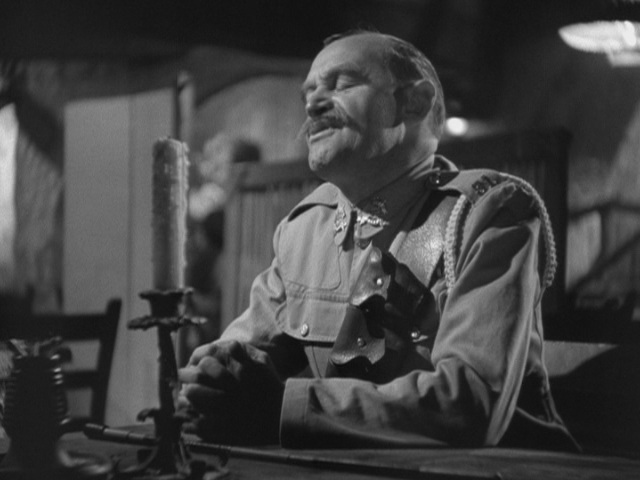
Absurdly favoured by Ford's direction: the shot introducing Barry Fitzgerald as Mulcahy – which is to say, the very first shot of Barry Fitzgerald in any John Ford movie. Men would kill for less.
However, the simultaneity of what is going on between these two groups is heavily underlined by the film’s narration when Wyatt and Rodney communicate with Geoffrey and Christopher via the instantaneous worldwide long distance telephone (imaged in a hyperbolic sequence of connection), achieving fictional real life simultaneity far more surely than even the most up-to-the-minute real life newsreel (which is one of Hauser’s examples of cinematic simultaneity).
Four Men and a Prayer – Video 1 from Screening the Past on Vimeo.
Note how movie simultaneity is demonstrably superior in every way to telephonic simultaneity.
A later telephone call from Wyatt and Rodney is at least initially placed in the narration in order to distract Geoffrey and Christopher from following up on Lynn’s disappearance after the conversation with Furnoy. They have been told to expect a call from India, and have just tried to ring up Lynn within the hotel at which they all are staying, but they are told she has departed without leaving any word for them. At first they believe that when the telephone rings anew it must be her, but it is the India call instead. Wyatt tells the others that the guns were manufactured by Atlas Arms, which they knew, and then that the President of Atlas Arms is in Alexandria and that his name is Martin Cherrington. The dialogue with Wyatt is at first shown in a commonplace way by means of alternate cuts (Brazil/India), but it finishes with a shot of Geoffrey (and us) listening as Wyatt identifies Cherrington – that is with an uncut instance of simultaneity furnished by the soundtrack. The immediate effect of this information is to trigger the sons’ suspicion of Lynn, Cherrington’s daughter. Christopher interprets Lynn’s various appearances in the story as a series of damming coincidences, that is, she has always turned up at the best moment to serve the interests of evil (simultaneity). Geoffrey has no answer to this; he is a prisoner of the structural strategy of the film’s narration.
Simultaneity and culpability: “a thousand folds, not one cut”
In formalist Soviet cinema a cut can be used to make an argument. When Eisenstein strings together images of a number of sculpted religious figures in October (1927), he is arguing the equivalence of the world’s religions as well as the degeneration of religion. Here the images virtually overlap one another, each re-iterates the others: they are fully, truly simultaneous. Now, Ford’s cinema is not usually montage-based, and the instantaneous/simultaneous links made between locations in Four Men and a Prayer is something of an exception to the rule. Ford’s cinema is a cinema of folding, an origamic cinema, in which elements that a scene or sequence offers can be recognised as an overlap of elements from other places in the film, none of them torn or cut from the formal narrative fabric but each retaining all of the intricate woven connections of the whole.
In Four Men and a Prayer and many, many other “classically” narrated films, simultaneity collapses/extends moral responsibility in a similar textural argument. The narration’s exposure of one villain after another – Furnoy for Loveland, Cherrington for Furnoy, and then vice-versa, each in turn telling us that no one can stop wars – is just this sort of commonplace simultaneity. It is also the case that, once asserted, films cannot withdraw such a guilty visual equivalence: it remains “the truth” in exactly the way that once asserted, nothing, not even a Royal pardon, can enitrely wipe away the “stain” of a guilty verdict. But if there are impediments to disproving something with words and deeds, it is infinitely more difficult to visualise a negative (which is one reason why so many movie protagonists are troubled by stupid, clunky dreams and so many critics are tempted to hermeneutical excess).
In Marlanda another unremarkable instance of overlapping equivalence takes place, as a cockney (Will Stanton) replaces Colonel’s Leigh’s batman, Mulcahy. They are both peasant figures and both are cast as crucial narrative helpers, the cockney mirroring/extending the foundation provided by Mulcahy. The cockney appears dragged onscreen by the Marlanda military in parallel with Geoffrey and Christopher’s entrance from screen right. First he claims to know Loveland. Then he mentions Muros Island and Atlas Arms. Once Geoffrey and Christopher get back to Buenos Aires, Wyatt and Rodney will tell them on the phone about Muros and the what seems like the final piece of the puzzle will fall into place, supplied then by one ur-Fordian figure made of two incarnations. Wyatt and Rodney will soon join the others for the remainder of the film, but Mulcahy and the cockney have done their bit, and like the revolutionaries of Marlanda they simply disappear.
If we needed any further evidence that this film was structured in lines of equivalence this uncanny parallel would surely seal it. But now see what happens to the equivalences as they take on ethical dimensions.
The film again makes a transition to an exotic location (Alexandria) by means of a title. Cherrington is concluding an arms deal with someone in traditional Arab dress who is called “His Highness”. Through a translator, Cherrington tells him that “the shipment can be made secretly” and says that Furnoy, “who is in charge of all operations”, will be in Alexandria in a few days. He is annoyed that Lynn has just landed in Alexandria. “How the dickens did she track me?” sounds awfully like he has taken some steps to make sure she would not find him.
When Geoffry meets Lynn as she gets off the boat in Alexandria, he accuses her of complicity in his father’s murder by saying, “When your father’s President of Atlas Arms …”, which asserts an equivalence between father and daughter, as if that is why he is rejecting her rather than the case of specific suspicious circumstances that Christopher listed after they had heard from Wyatt and Rodney in Buenos Aires. In retaliation Lynn treats all the brothers as though they are interchangeable. Both Geoffrey and Lynn have employed arguments of equivalence as screens for their actual understanding of each other’s difference.
Lynn is actually very angry that her father would have condoned the kind of business practice which lead to the slaughter of the rebels in Marlanda. But look over Cherrington’s defence, which at two points tries just as hard as Geoffrey has to substitute Lynn for himself as well as himself for “somebody else”, and ask yourself how convincing it is.
Cherrington: Listen Lynn, I know that war is agony, filth and horror. It’s mass stupidity and collective insanity.
Lynn: You know all that and still you going on selling arms?
Cherrington: If I don’t do it, somebody else will. Besides, you know, you’re pretty expensive with your globe-trotting ideas.
. . .
Cherrington: War is all you say it is and more, but I’m not responsible if fools want to cut each others’ throats. My factories turn out guns, among other things. Now if men want to buy them and make hell on earth, they might just as well buy them from me. But if they ever see reason, I’d be delighted to shut down my plants. Now you know where I stand.
Lynn: Dad, you’re talking about men as if they weren’t even people. I’ve seen them die, slaughtered like animals.
Cherrington: It’s your fault for messing around such places.
. . .
Cherrington: What on earth makes you think that I was in on this [the murders of Colonel Leigh and Davies]?
Lynn: Well, because Atlas Arms is responsible for everything that has occurred, and you are Atlas Arms.
. . .
Cherrington: Gentlemen, I hold the conportant [?con[trolling] [im]portant] shares in many companies including Attis [Atlas], but I don’t control iss [its] policy. I want you believe I didn’t know that policy included … murder.
Lynn: Oh Dad, can you prove that?
Cherrington: Oh yes, if necessary. I make plowshares, locomotives, and tractors, and even safety razors. My stock in Atlas will be sold at once, I promise you.
Really all this rhetoric is terribly familiar. We hear it almost everyday from politicians, bureaucrats, businessmen and their apologists. Yet I was surprised to find this kind of deniability argument in a lightweight adventure movie from the late thirties. What Cherrington says shifts Four Men and a Prayer back into a realm of hyperbolic seriousness, confronting us with the corruption and hypocrisy of the generation that now controls the globe, perhaps even more today than seventy years ago. And Lynn’s all-too-easily elicited cri de coeur, “Oh Dad, can you prove that?” only makes the situation more familiar and more depressing. (Of course he can; “I guess a man in my position could legally wriggle out of that” he will say – which is to say, of course he can’t really prove anything. He can’t because he is, after all, guilty.)
Critics do like to point out that Alan Hale is (sort of) cast against type in this movie because he is playing Furnoy, a villain. [18] But Berton Churchill is definitely not playing against type in Four Men and a Prayer. Churchill was always cast by Ford as someone whose word you could not trust (a hypocrite or con man). His roles for Ford in the films of the box set: Herbert Banning (Doctor Bull), Senator Horace Maydew (Judge Priest), The New Moses (Steamboat Round the Bend). Watch him weasel out of the situation and finger his principal henchman.
Wyatt: But you must know who does control the policy of Atlas Arms.
Rodney: And you’ve got to tell us, sir.
Cherrington: No,no sonny, I haven’t.
Lynn: Oh Dad, you do.
Wyatt: May I suggest sir, that if you protect him, you make yourself an accessory to those murders?
Cherrington: Well I guess a man in my position could legally wriggle out of that. But I don’t hold with murder and the man who is responsible knows I don’t. That’s why he’s kept me in the dark. Guess you boys want him pretty badly, don’t cha?
Geoffrey: Naturally, sir.
Cherrington: Well then, you’ll have to hustle. Sailing on his yacht tonight for Singapore. His name is Furnoy.
Everyone else is amazed and they all rush out of Cherrington’s VIP suite. In the confusion Christopher discharges his popgun. No one on the screen thinks that Cherrington has just shot himself, but surely I am not the only viewer who hopes he has.
Furnoy is going to “sneak out” of Alexandria and head for Muros Island, “not Singapore”. He is on board that yacht and he is drunk. [19] Why is he sneaking out and why has he decided not to go to Singapore? Perhaps a better question would be, “Why is he in Alexandria at all?”. Surely now he knows that Cherrington has thrown him to the wolves, but just as surely he must have come to Alexandria expecting that this would not happen, that is, that Cherrington would continue to protect him. If any more proof were needed, the touching faith displayed in this act shows where the real villainous power lies. The boys (minus Lynn) swim over and bail Furnoy up in Bulldog Drummond vigilante style. He confesses (to what we never learn) and that is the last we see of either Furnoy or “Dad”. The new, younger, family shown in the still at the beginning of this review is about to fly back to Never Never Land.
Oh yes. I nearly forgot …
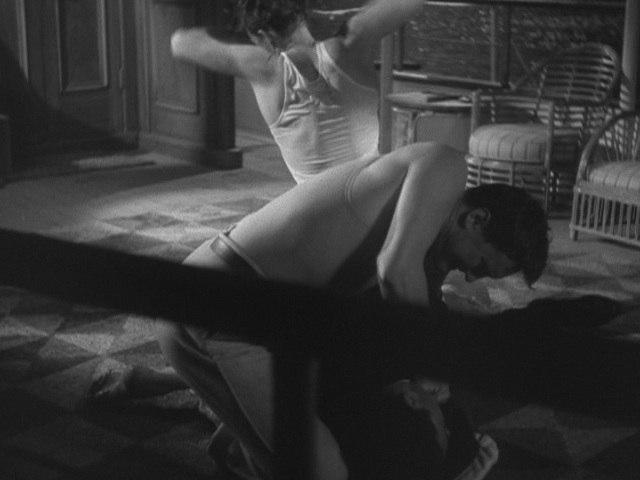
Honi soit qui mal y pense. Note the discrete placement of foreground shadow. The whole sequence is a prolonged fantasy about male torsos, wet shirts and sado-masochism which neatly prefigures Kenneth Anger's Fireworks (1947).
Of course Ford and Anger would not have known each other in 1938, even though the latter had appeared in Max Reinhardt’s A Midsummer Night’s Dream just three years before.
*
Paris Pick Up or Why did he call it that?
That is, why did Bertrand Tavernier call his article on John Ford “La Chevauchée de Sganarelle”? One good way to start to answer that question would be to translate the title into English. “Chevauchée” means “ride”, as in “I am going to take a ride”; there is also a sense of a group in the word, which can in certain contexts be translated as “cavalcade”. “Sganarelle” is a name, so the title of Tavernier’s essay is “Sganarelle’s Ride”.
Well, the idea of a ride certainly connects the essay to Ford’s best known work, his westerns – even, via “cavalcade” to “cavalry”. But there is no character called Sganarelle in any of Ford’s films that I know of. In fact Sganarelle seems to have appeared in no film made exclusively in the United States (I think it must be because Americans aren’t able to pronounce the name). However, an Internet Movie Database search for the character produces an interesting list of titles, all of which connect the character to the French playwright, Molière (Jean-Baptiste Poquelin). [20] Sganarelle was one of Molière’s most popular and enduring inventions; and at least six of Molière’s plays were used as sources for the films and television programs on the IMDb list.
I have extracted some of the titles which attracted my attention.
La fin de Don Juan (Victorin Jasset 1911 – French film). This short film was almost certainly a re-staging of the “big scene” from Molière’s Dom Juan. Jasset began to direct the Zigomar series of serials in 1911 and that is what the history books tend to know of him.
Le médecin malgré lui (No director credit, 1938 – British TV). A very early date for television, but not an unexpected one for British TV. First appearance of Sganarelle speaking English in audiovisual media?
Don Juan (John Berry 1956 – Spanish film). Fernandel plays Sganarelle in this film, and Juan Antonio Bardem is credited with the screenplay and dialogue. The film was a French-Spanish-Italian co-production and was released in the US.
Le médecin volant (Ange Casta 1961 – French TV), Le médecin malgré lui (François Gir 1964 – French TV), Dom Juan ou Le festin de pierre (Marcel Bluwal 1965 – French TV). A cluster of French television productions, one of which is considered a truly important moment for French cultural television (more of this below). There is an intriguing correspondence between the dates of the last two of these productions and the date (March 1965) of Tavernier’s article.
In the 1981 French TV production, Les plaisirs de l’île enchantée, Alain Pralon plays both Molière and Sganarelle, which reinforces the idea that at least some people believe that Sganarelle (at times) embodied Molière’s point of view.
Dom Juan (Ingmar Bergman 1985 – German TV). Danish and Swedish TV also produced Molière’s plays (in clusters), making Molière a European cultural icon, not just a French one.
La Comédie-Française ou L’amour joué (Frederick Wiseman 1996 – French/US documentary film). In Wiseman’s film a number of iconic Comédie-Française characters appear, Sganarelle among them. The film was shown in the US.
Don Juan (Jacques Weber 1998 – French film). Actually a Spanish-French-German co-production.
This last title is on my list because of the opening lines of the IMDb plot summary, written by L.H. Wong: “Spain in the mid-seventeenth century. A series of bloody wars has ravaged the nation. Don Juan the nobleman and his valet, Sganarelle, roam the countryside on horseback, on the run and lost.” And that summary is of interest because it is actually in Dom (or Don) Juan that Sganarelle’s ride takes place, in the wake of Don Juan’s. Sganarelle is the peasant servant of Dom Juan, a relationship that clearly points back to the relation of Sancho Panza and Don Quixote. He rides after his master, tracing a path that comments on Dom Juan’s degenerate, romantic aristocracy.
Tavernier, then, uses Sganarelle’s name to refer to Molière’s character and specifically to its appearance in Dom Juan. And I believe he implies that John Ford himself has something like Sganarelle’s point of view of the world, that Sganarelle’s ride is also Ford’s.
Perhaps one aspect of what Tavernier may understand by Ford’s peasant cinema can be discerned in the last words of Molière’s play.
SGANARELLE, alone
Oh! my wages! my wages! By his [Dom Juan’s] death every one gets satisfaction. Heaven offended, laws violated, girls led astray, families dishonoured, relatives outraged, wives ruined, husbands driven to despair, they are all satisfied; I am the only unlucky one. My wages, my wages, my wages!
Sganarelle is dissatisified with the apparent completeness, the “classical unity” of the fiction in which he has appeared. He directs our attention to what has not been done, what Dom Juan has left unfinished. In Sganarelle’s eyes narrative closure, the well-made story, is an upperclass deception which ignores the exploitation of the lower classes that make it possible. In this context I cannot but be reminded (again) of the ending of Four Men and a Prayer – hardly the only “unsatisfactory” ending in Ford’s oeuvre.
Another way to find out why Tavernier called his essay “La Chevauchée de Sganarelle” would be to ask him. So I sent him an email, and this is what he replied: “I used Sganarelle because he seemed to me a very fordian character, one of those sharp, astute, manipulating “peasants”, rural heroes which are so important in Ford’s film”. [21] Not all that I would have had hoped, but near enough.
I also asked Tavernier if he had been at all influenced by Marcel Bluwal’s 1965 production of Dom Juan for French television. He said nothing in reply to this, and I take it that he was not. I do not know whether anyone had actually seen the production, which was released on the 6th of November 1965, before Tavernier wrote his article, which was published in the March 1965 issue of Présence du cinéma, but it is not impossible that at least some cineastes in Paris at the time would have been aware that such a telefilm was being made, and that it was being made by Bluwal, who enjoyed a certain reputation for his intelligent, sophisticated and modern adaptations of literary classics for television. On the other hand, Bluwal’s medium by then was television and his genre and treatment was one that smacked of “le cinéma du papa” – which is to say, the misunderstood and despised work of an earlier generation of “classicists”. It is perfectly reasonable, even mandatory, to take Tavernier at his (absent) word.
But to an historian and critic writing today, the title of the essay nonetheless reads, or misreads, as a gesture, a hommage to, or reminder of, Bluwal’s Dom Juan. For sensible people such a reading transports us (for you, my likeness, are complicit in this insofar as you read and understand me), to the limit of criticism: a point at which we know we have taken leave of commonsense and admit we inhabit a world in which words and structures matter more than What Really Happened. But have I ever suggested anything else? Have you ever thought anything else?
Let us see what we can find out.
From an interview with Marcel Bluwal on Dom Juan ou Le Festin de pierre:
What is Sganarelle’s role in this ride of Don Juan’s towards death?
Sganarelle follows Dom Juan on a mule because Dom Juan’s ride is also a roaming, an interrogation of the direction [sens] of life. My film is at times inspired by certain pictures: Daumier’s Quixote and Sancho, Delacroix’s Faust and Mephisto, Durer’s The Knight and Death.
Molière is usually assumed to have used Sganarelle as a kind of Greek chorus that comments on the actions and bearing of its “betters”. Thus the peasant Sganarelle assumes some of Molière’s own point-of-view. But Molière is not to be subsumed into Sganarelle, and the author remains at an empathetic distance from his character. This is what I have assumed happens with John Ford’s “peasant point-of-view”: Ford encompasses it but also comments on it.
Ford notably avoided filming “the classics”, perhaps in part because he did not like the idea of having to represent such a pervasive point-of-view as those offered by literary figures like Scott, Dickens or Mark Twain (not to mention Molière). For Bluwal in France in 1965 the situation is somewhat different. At that point it can be taken as given that it is possible for a true cinematic “auteur” to encompass even the strongest literary personality and to assert its self at the same time. Bluwal only needs to identify where his auteur print can be found in this new interpretation of Molière’s text.
To interpret Sganarelle you have chosen Claude Brasseur, while the role of Dom Juan is taken by Michel Piccoli. Why?
I chose a Sganarelle (C. Brasseur) younger than Dom Juan (M. Piccoli) to underline the distraught admiration even in the valet’s criticism of his master. I wanted to translate that quite particular relation that couples have in Molière’s theatre (think of the Misanthrope and Philinte, Tartuffe and Orgon), a relation between friends which resembles that of lovers. Molière, like Shakespeare before him, set up no fundamental difference in the affectivity of couples of men and women, and it is not necessary to tax him with homosexuality for all that. [22]
No, one wouldn’t want to tax Molière with homosexuality – at least not in 1965. However, Claude Brasseur is also in Bulwal’s Le plus beau pays du monde (The Happiest Place on Earth) thirty-four years later.
STILL: LE PLUS BEAU PAYS DU MONDE (2).jpg
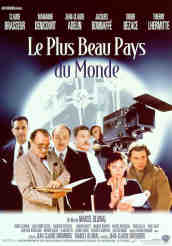
“The story of Robert Hughes-Lambert, who was captured by Nazis when his active homosexuality was discovered during the filming of Mermoz (1943).” (IMDb). One French site calls this a “comédie dramatique”.
For those who may be intrigued by all of this, I should like to point out that one of Bluwal’s recent mini-series was shown in February 2011 with English subtitles on the Eurochannel. (I missed it). Unlike Le plus beau pays (so far as I have been able to ascertain), it has had a French DVD release.
STILL: -droite-toute-23051172.jpeg
I am taking all this space with titles and pictures that are not strictly relevant to John Ford’s films because it seems to me that Marcel Bluwal, who is I believe still alive as of this writing, is long overdue for discovery and assessment by English-speaking cinema buffs and historians. Perhaps some will discover him through the non-fiction film about him released in January 2011, Cours mon âme, la nuit est proche (Sebastiano d’Ayala Valva).
Description: A portrait of the television director, Marcel Bluwal, the last of the first generation of such directors still active in France. After having adapted the masterworks of European literature for the small screen for 50 years, Bluwal began to write his own scenarios at the age of 83. The mask dropped. [23]
I guess this means that Marcel Bluwal is my Paris pick up.
[1] Joseph McBride, “Ford at Fox: A Great Director’s Professional Home”, in Ford at Fox (Twentieth Century Fox, 2007), p. 17.
[2] “La Chevauchée de Sganarelle”, Présence du cinéma No. 21 (March 1965), p. 2. This fine piece of critical writing has been reprinted in Tavernier’s Amis Américains: entretiens avec des grands auteurs d’Hollywood (Institut Lumière 2008). I must thank Sam Rohdie for reminding about this productive piece of criticism and for pointing me towards that mammoth book, the biggest single volume in my house and the wonder of all who see it. Translations from Tavernier which appear here are my own.
[3] Quoted in Peter Bogdanovich, John Ford (Berkeley: University of California Press, 1968), p. 69.
[4] In point of fact, there is a lot in the film that reminds me of Wee Willie Winkie. Not only does it begin in India with C. Aubrey Smith playing the same conventional type of character that he did in that film, but the issue of “civilisation” against traditional indigenous culture is foregrounded, not to mention conflicts of generation and gender. See later comments on “peasant cinema” and on the American woman in note 11.
[5] Bogdanovich: “You seemed to have a tongue-in-cheek attitude about all that British stiff-upper-lip business” … Ford: “I kidded them slightly” (p. 69).
[6] No one seems to have made a big deal of the apparent fact that William Faulkner is supposed to have worked on the screenplay uncredited. But Faulkner had a strange sense of humour and of the British (see, for example, Today We Live, 1934) and so does Four Men and a Prayer.
[7] It isn’t, or at least not the only one. After his father’s murder Wyatt dons spectacles which he only takes off once the four sons have worked out who their father’s murderer actually was. Watch out, Sigmund Freud.
[8] Tavernier, “La Chevauchée de Sganarelle”, Présence du cinéma No. 21 (March 1965), p. 4. All subsequent page references to this text are contained in brackets in the main text of this review.
[9] Time in the Sun, Marie Seaton’s version of Sergei Eisenstein’s Mexican film, premiered in New York in October 1939, which means it had been around for some time before that. But Thunder Over Mexico (1933), Eisenstein in Mexico (1933), and Death Day (1934) had preceded Seaton’s edit. I am less interested in arguing for any direct influence of Eisenstein’s footage on Ford’s imagery than I am in suggesting that the association of Mexican revolution with the radical left was virtually automatic in the United States during the thirties, and thus that the “Mexican” character of the sympathetic images of the revolutionaries in Four Men and a Prayer marks them as “leftwing”. Moreover, this association had a specifically cinematic source in Eisenstein’s work, a director whom Ford had directly “quoted” in Four Sons – a film with a purely coincidental parallel to Four Men and a Prayer.
[10] See Blomberg’s interesting list of credits on the Internet Movie Database: http://www.imdb.com/name/nm0111297/
[11] Lynn is as much, perhaps more, of an example of the American woman as Joyce is in Wee Willie Winkie. To Geoffrey: “We’re going slumming, dancing! We’re going to drink champagne and listen to Negro orchestras! That’s good medicine for your correct English soul, my son.” This seems to put her American woman effortlessly in alliance with non-Western, non-British elements. Geoffrey decodes (works) them, she lives (plays) them. What becomes an American woman, what such a woman can or ought to do, occupies a great deal of the film’s thinking, alongside what (therefore) becomes a man (whimpering? glasses? … are they all boys?): “Obey? Oh Douglas, that was your biggest mistake. Stand aside, I’m on my way.”
[12] When I reread Tavernier’s words preparing this review, I was struck by their similarity to one of Robert Warshow’s most interesting critical aperçus: his description, first published in 1954, of what the hero of a western movie is fighting for.
What he defends, at bottom, is the purity of his own image – in fact his honor. This is what makes him invulnerable. When the gangster is killed, his whole life is shown to have been a mistake, but the image the Westerner seeks to maintain can be presented as clearly in defeat as in victory: he fights not for advantage and not for the right, but to state what he is, and he must live in a world which permits that statement. (Robert Warshow, The Immediate Experience, Atheneum, 1970, pp. 140-141).
Warshow then goes on in the next paragraph to say, “Honor . . . is a style, concerned with harmonious appearances as much as with desirable consequences, and tending therefore toward the denial of life in favor of art,” which also can be applied to Ford’s work. Strange then, I should think, that Warshow was not much impressed with Ford’s best known westerns, which he declares display an “unhappy preoccupation with style” (p. 149), when he so clearly agrees with Ford about the relation of heroism to style.
[13] Ernest Klein, A Comprehensive Etymological Dictionary of the English Language (Amsterdam: Elsevier 1971), p. 542.
[14] Arnold Hauser, The Social History of Art, Volume 4: Naturalism, Impressionism, the Film Age (New York: Vintage Books 1958, orig. pub. 1951), pp. 226-259.
[15] Hauser, p. 243. The discussion of simultaneity occupies pp. 219-246.
[16] Which is a pity because Rodney gets some lovely lines in this scene (“She was just showing me how she liked to welcome home her erring knight when the popgun went off!” and, “Don’t flutter like an old hen, Beano, I can dig my own worms”), but William Henry is such a loser actor that you have to pay close attention to hear them at all.
[17] “Ford’s first friendly barroom brawl” according to Gallagher (163).
[18] Ford first used Hale as Colonel Moreau, the villain in Cameo Kirby (1923).
[19] Note the line of alcohol from Cherrington to Furnoy. Berton Churchill slurs his words and even bobbles “conportant” (Gallagher’s “hysterically sober” characterisation sort of misses the point); Furnoy (not Alan Hale) is (fictionally) drunk as he talks to his captain. If John Ford is “in” this film at all, he may be in the drink.
[20]You can also make that connection by looking up Sganarelle on the Wikipedia. That is how I originally did it, but the IMDb connection makes a better, tighter story.
[21]Bertrand Tavernier to author, 25/02/2011.
[22]http://www.cinema-musique.org/cinema-photo-film/spectacle-oscar-theatre/DomJuanouLeFestindepierre.php. This page, in French, is devoted to Bluwal’s Dom Juan. The translation is mine.
[23]This description of the film (in French) appeared with a preview of it on YouTube. Both have disappeared, and I have translated the French. Here is a link to one place where the film is mentioned as of this writing: http://www.berlinale-talentcampus.de/campus/project/profile/73145

